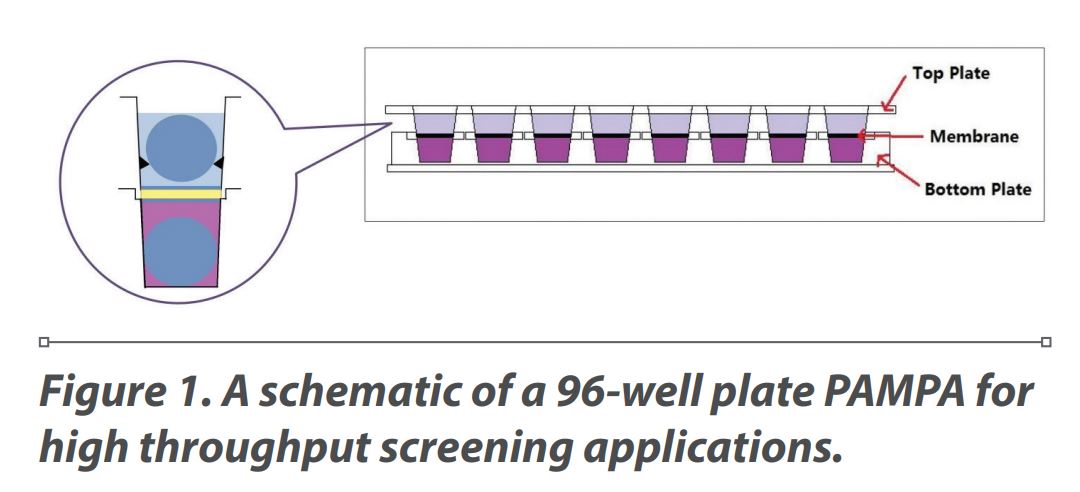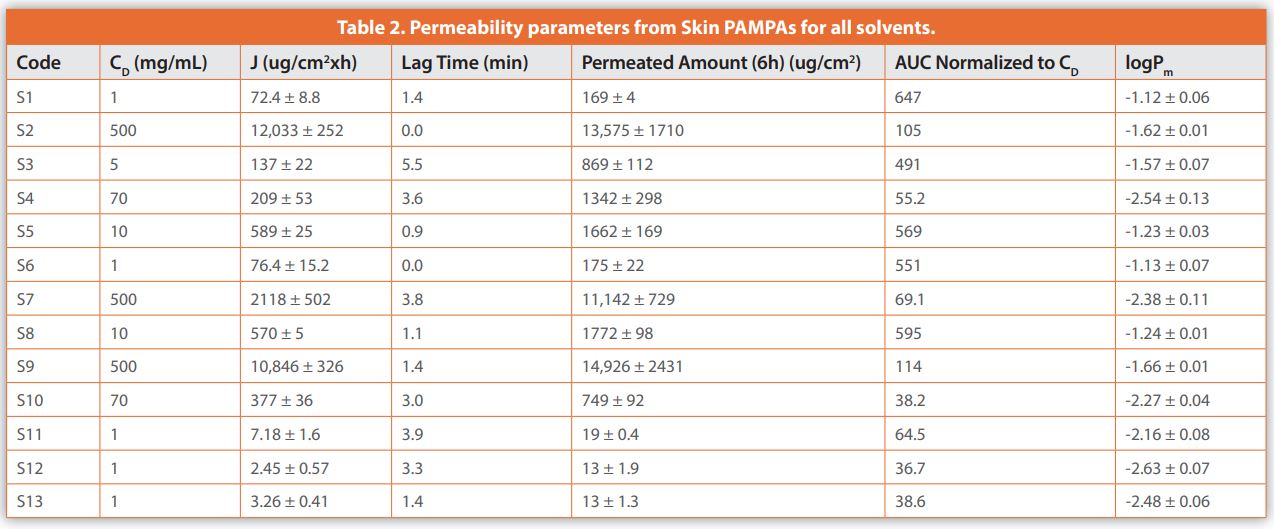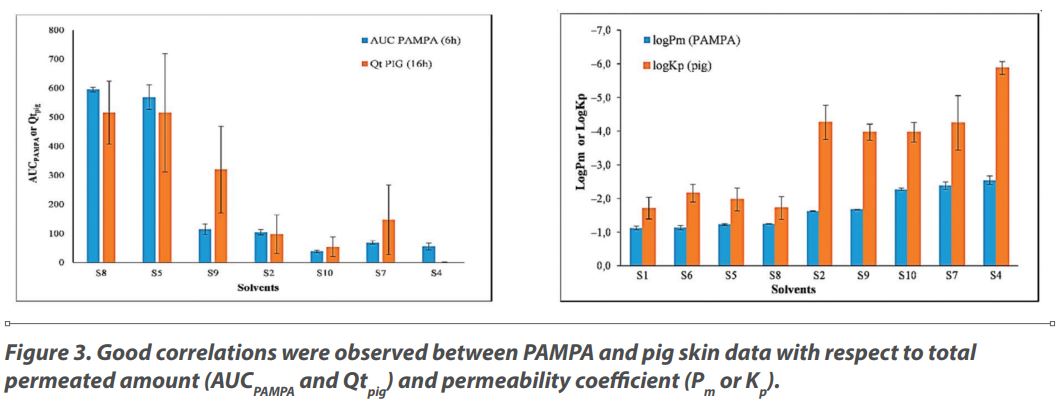Bálint Sinkó, Manager, Technology Development, Pion Inc.
Transdermal drug delivery is a pain-free, non-invasive alternative to other parenteral options such as injection and infusion that similarly avoids first-pass metabolism in the gastrointestinal tract. Gels, semisolids, and patches for transdermal drug delivery enjoy high patient acceptance and are used routinely for the sustained delivery of hormones and drugs for the relief of nausea and pain. Absorption through the stratum corneum is a critical first, and often rate-limiting step, and an important focus during formulation, creating a need for relevant testing. Traditional in vitro permeability methods provide useful data but tend to be relatively low throughput. Higher throughput assays are therefore highly desirable.
This article discusses the use of a novel Parallel Artificial Membrane Permeability Assay (PAMPA) with a design amenable to automation and high throughput testing to assess the permeability of a model compound in various solvents. Data comparison with analogous results measured with ex vivo pig skin, an accepted alternative to human skin, demonstrates the utility and relevance of the applied method.
Formulating for Transdermal Delivery
The skin is structured with three discrete layers: the epidermis, the dermis, and the hypodermis. The hypodermis or subcutaneous layer consists predominantly of fat cells that perform a cushioning and insulating role. The dermis lies closer to the surface and incorporates a network of capillary blood vessels that are targeted for systemic drug delivery. The epidermis is the outermost layer and can be sub-divided into viable epidermis and the stratum corneum, the very outermost 15 - 20μm layer that forms a highly effective barrier with the external environment. The stratum corneum combines high density with low hydration and is made up of non-living corneocytes composed predominantly of insoluble keratin sandwiched together by lipid-based ‘intracellular mortar’1 containing ceramides, cholesterol, and other fatty acids. It is poorly amenable to drug transport. Effective penetration of the stratum corneum is therefore a primary goal when it comes to the formulation of transdermal products.
Methods used to enhance absorption through the stratum corneum can be classified as active or passive. Active methods include the use of microneedles, electrical assistance, and techniques such as thermal ablation. In contrast, passive methods focus on formulation chemistry and include the use of chemical penetrants, drug delivery vesicles such as liposomes, and prodrugs, drug substances that metabolize into an active form in vivo.2 With these strategies, success relies on increasing either drug solubility - thereby creating a higher driving force for drug transport - or permeability, making it easier for the drug to transit through the stratum corneum. For example, changing solvent may substantially enhance drug solubility. Chemical penetrants on the other hand, such as sulphoxides, essential oils, and alcohols, target permeability via a wide range of mechanisms including hydration of the stratum corneum or increased fluidity within the inter-corneocyte pathways.2
Permeability assays have a vital role to play in the elucidation and development of passive methods. Human skin is widely recognized as the gold standard for in vitro permeability assessments though international guidelines such as those issued by the OECD3 identify pig skin as an acceptable alternative. Synthetic membranes developed to model key features of the stratum corneum are a more practical option for routine testing and are also widely used. Though such membranes cannot capture the full complexity of the stratum corneum they have proven to be sufficiently representative to be extremely useful, especially for screening studies. Developing test apparatus that optimizes the use of such membranes is an important goal for accelerating the development of effective passive formulation strategies.
Introducing a Novel Test Set-Up for Screening Transdermal Formulations
Traditional in vitro techniques for assessing permeability such as the Franz Cell can be applied using either ex vivo or synthetic membranes and play an established role in the assessment of transdermal products. However, low throughput limits their suitability for early formulation development. Figure 1 shows a schematic of an alternative in vitro Skin PAMPA that addresses this problem.

This apparatus has a double layer 96 well-plate design for automated, high throughput screening. When assembling the ‘sandwich’, the upper plate is fitted with a pre-coated artificial membrane specified to closely mimic the lipid matrix of the stratum corneum. The wells of the top plate form the donor compartments for samples of solutions, lotions, creams and gels, while the wells in the bottom plate contains an acceptor solution. Incorporation of a stirrer disk maintains acceptor homogeneity during testing. Drug transport through the filter supported artificial membrane is monitored using a UV-plate reader.
PAMPA technology has been used successfully for comparative testing to identify excipients that enhance gastrointestinal absorption, in the formulation of oral drug delivery systems.4 They have also demonstrated high prediction capabilities and utility for a range of transdermal drug delivery products, for both semisolid formulations and transdermal patches.5-7 The following case study illustrates this potential by showcasing the use of a Skin PAMPA in an assessment of the permeability of a model drug compound in a range of alternative solvents.
Case Study: Assessing the Permeability of 4-Phenylethyl Resorcinol (PER) in Different Solvents
A study was carried out to investigate the performance of different solvents with respect to the transdermal permeability of 4-phenylethyl-resorcinol (PER).8 PER is a non-polar weak acid used as a skin-lightening agent in both cosmetic and dermatologic formulations. The chosen solvents – nine pure solvents and four simple solvent mixtures – are all approved for cosmetic use and can be classified as low-molecular-weight (MW) polar, low-MW polar ‘glycol’ and high-MW non-polar (see Table 1). PER was selected as a model compound due to its physicochemical properties, solubility in a wide range of solvents and good UV absorption, the latter making it an excellent candidate for detection with a UV plate reader.
The study proceeded via the following steps:
- Solubility measurements – to establish saturation conditions for PER in each solvent to support testing under infi nite conditions i.e., conditions where drug availability in the donor cell is not limiting with respect to permeation.
- Permeation assays with synthetic membranes – to generate values of permeation coefficient (Pm), flux (J) and amount of drug penetrated in a finite time (Qt).
- Permeation assays with pig skin, for a limited number of solvents (9 out of 13) – to generate comparable values of permeation coefficient (Kp), J and Qt to validate the preceding assay and determine the most relevant metrics for solvent screening.
Solubility Measurements
The approximate saturation solubility of PER (CAS 94-77-9, SymriseTM) was determined in each of the solvents (all L’Oreal) at 32°C (temperature of the surface of the human skin) in accordance with OECD test guidelines.9 This semi-quantitative method involves quantifying the volume of solvent required to completely dissolve 0.1 g of PER within 1 hour. From these values the solvents were grouped into five solubility classes which were subsequently used to define concentrations for the permeability assay. For the solvents used in pig skin assays, solubility was also determined by making up solutions at the upper limit of the solvent’s designated solubility class (as determined by the semi-quantitative method) centrifuging at 14000 rpm, and then analyzing by LC/MS/MS.
Comparing values for PER approximate solubility (semi-quantitative method) and PER Equilibrium Solubility (LC/MS/MS) (see Table 1) shows good agreement for most solvents, confirming the validity of the semi-quantitative approach. Results for the two solvents exhibiting the highest solubility – S2 and S9 – are the exception with the semi-quantitative method producing significantly higher values.
To quantify the lipophilicity of PER, logP was measured in an octanol/ water system at 25°C, using standard shake flask methods. LogP values quantify how a solute distributes between oil and water phases and can therefore help to rationalize solubility data. The measured logP for PER was 2.98 which indicates it is sparingly soluble in water (highly polar) and highly non-polar organic solvents. Solubility data for S1, S6 and S11 – S13 all reflect this. In contrast the logP value suggests high solubility in semi-polar organic solvents and associated mixtures as evidenced by the data for S2, S7 and S9.
Tests were also carried out to determine the equilibrium intrinsic solubility of PER in the acceptor medium again using saturation shake flask methods. PER solutions in each solvent, made up to the concentration specified for permeability testing, were added to 5mL of Prisma buffer solution, the selected acceptor phase, until solid sample appeared. The resulting sample was then subjected to stirring (6h) followed by sedimentation and dilution (as required) to determine the saturated concentration of the solution by UV spectroscopy. All measurements were carried out at 32°C in triplicate. These tests recorded an intrinsic solubility for PER of 3.45 +/-0.01mg/ mL. An upper concentration limit of 0.345 mg/mL (10% of intrinsic solubility) was therefore set for the acceptor compartment to maintain sink conditions throughout the assays.
Permeability Assays using Synthetic Membranes
Membrane integrity tests were carried out by contacting solvent (in the absence of any active ingredient) and membrane for extended incubation periods (minimum 7 h) using the Skin PAMPA apparatus and then carrying out standard permeability assays with piroxicam, a model permeant for which precise reference data are available. None of the solvents changed the visual appearance of the membranes and the recorded log Pm values of piroxicam (-3.82 to -4.81, with a mean of -4.25+/-0.3) were in good agreement with the reference value of - 4.98 ± 0.01. Furthermore, there was no evidence of high standard deviation values, a normal indicator of membrane corruption.
The solvents were therefore all considered compatible with the membrane and suitable for the study.
Permeability assays were carried out with each of the solvent systems using a commercially available Skin-PAMPA apparatus. Membranes were hydrated overnight prior to use using standard hydration solutions and the assembled Skin PAMPA was incubated at 32°C. Acceptor solutions were sampled after incubation periods of 7.5, 15, 30, 60, 120, 240 and 360 min and analyzed via UV absorption measurements at a wavelength of 280 nm. The acceptor phase was replaced with fresh buffer solution after each individual incubation period.
The Skin PAMPA results were used to generate cumulative permeated amount of PER (per cm2 ) vs. time plots as exemplified by Figure 2 which shows data for water. Such plots remain linear until acceptor concentrations reach the limit of solubility or donor concentrations decrease significantly. For water, this point is reached as incubation periods exceed 60 minutes. Mean mass transfer rate or J and lag time values are calculated from the linear portion of this profile to avoid the impact of these limitations, via the linear regression of data gathered at incubation periods up to 30 mins (see Figure 2b). J (μg/ cm2 *h) is the slope of the linear equation while lag time (mins) is the x-intercept.
Permeability coefficients, which are indicative of the rate of penetration through the membrane, are calculated by dividing J by CD (concentration in the donor phase). Area Under the Curve (AUC) values, which quantify Qt were determined by integration of the permeability profile, from 0 to 6 hours.

Table 2 shows Skin PAMPA data for each of the solvents/solvent mixtures. Lag times were found to be less than 6 minutes for all solvents indicating universally fast membrane saturation. However, appreciable differences were observed in other permeability metrics, highlighting the influence of solvent choice. The highest permeabilities were observed with aqueous solvents, with water (S1) or solvent mixtures with a high water content (S5, S6 and S8). In contrast, permeability was lowest in low MW polar organic solvents that exhibited good PER solubility (S4, dimethylisosorbide and S7 propylene glycol) and high MW non-polar solvents that provided sparing solubility (S12, apricot kernel oil and S13, corn oil).
Comparative Permeability Assessments with Pig Skin
Permeability assessments for nine of the solvents/solvent mixtures (as highlighted in Table 1) were also carried out using shaved pig ear skin samples with a thickness of between 700 and 1200μm. The integrity of the skin samples was confirmed using the Trans-Epidermal Water Loss method, using a Delfi n device. Penetration testing was carried out under infinite dose conditions (1.13 ml/cm2), sampling the receptor fluid (sodium chloride solution + 0.25% v/v Tween 80), on an hourly basis up to 16 hours. Each 200μL sample was replaced with fresh receptor fluid and analyzed by LC/MS/MS.
Permeability parameters, including permeability coefficient Kp and J, were determined from plots of cumulative permeated amount of PER (per cm2 ) vs. time using analogous methods to those applied for analysis of the Skin PAMPA data (see Table 3). Similarly, permeated amount, Qtpig was determined by integration of the area under the permeability profile, up to 16 hours.
Absolute values of flux were much higher in the Skin PAMPAs than in the pig skin tests and anomalies/outliers were observed when the two sets of data were compared in terms of this metric. Better correlation was observed between permeated amount values as quantified by AUCPAMPA and Qtpig (see Figure 3 - left) though two outliers were observed, S1 and S6 (data not shown). Excluding these two solvents results in an R2 of 0.843, an acceptable correlation.
However, the best correlation was observed when permeability coefficients - logPm and logKp values - were compared (see Figure 3- right). Permeability values were higher with the synthetic membrane than with pig skin, an expected result given the greater thickness and multilayered nature of the pig skin, but an R2 of 0.844 was observed with no outliers, indicating good correlation for all nine solvents. Both assays indicate that solvents S2, S4, S7, S9 and S10 deliver higher permeability than the other four alternatives. The relatively large differences in the data observed for S4 (dimethylisosorbide) and S2 (ethanol) may be attributable to disruption of the synthetic membrane by PER-saturated solutions. Such effects are significantly reduced when these organic solvents are used in aqueous mixtures (S6 and S5 respectively).

The preceding analysis highlights how rankings of permeation potential can change depending on the metric chosen for comparison. It is important to note that flux is the product of permeability and donor concentrations. When tests are carried out at donor concentrations close to saturation values higher solubilities are therefore likely to give rise to higher values of J, even when permeability remains constant. In this study, solubility rankings were reflected in J values but there were important exceptions. For example, though PER solubility was comparable in water and corn oil (1mg/mL) J values were around 17 times higher for water. In contrast, permeability coefficients are independent of concentration and may therefore be the preferred metric for comparison in studies such as these involving a wide range of solvents exhibiting substantial variability with respect to solubility.
Assessing the Practicalities of Skin-PAMPAs
In this study Skin-PAMPA were performed over a 6h incubation period allowing far higher throughput than is feasible with the single solvent penetration tests used to generate comparable data for pig skin, each of which took over 16h. This is a major gain however, the Skin-PAMPA approach does have some important limitations, notably
- Requirements for precise pipetting
- Simulation of the outermost layer of the skin only. If excipients are impacting/damaging this layer then permeation can be overestimated.
In Conclusion
Skin-PAMPA is a valuable approach for high throughput screening activities associated with the development of transdermal products, particularly in early-stage formulation. The results presented here add to previously published work demonstrating its utility and confirm the validity of the technique via comparison with penetration studies of pig skin. A wide range of solvent types were classified efficiently and relevantly with respect to permeability, far more quickly than is feasible using traditional testing strategies; permeability coefficient proving the most relevant metric for comparative assessments. The results clearly demonstrate the potential of Skin PAMPA as a screening tool for solvents and other excipients.
References
- Prausnitz, M and Langer, R. “Transdermal drug delivery” Nat Biotechnol 2008 Nov; 26(11):1261-1268
- Alkilani, A.Z; McCrudden, M.T.C; and Donnelly, R. F; “Transdermal drug delivery: Innovative pharmaceutical developments based on disruption of the barrier properties of the stratum corneum” Pharmaceutics 2015 Dec; 7(4):438-470
- OECD Test No. 428: Skin Absorption: In Vitro Method. In OECD Guidelines for the Testing of Chemicals, Section 4; OECD: Paris, France, 2004.
- Avdeef, A. “Absorption and Drug Development: Solubility, Permeability, and Charge State” 2nd Edition. First Published 7th May 2012. John Wiley and Sons.
- Sinkó, B.; Vizserálek, G.; Novák, K.T. “Skin PAMPA: Application in practice.” ADMET DMPK 2015, 2, 191–198.
- Balázs, B.; Vizserálek, G.; Berkó, S.; Budai-Sz ̋ ucs, M.; Kelemen, A.; Sinkó, B.; Takács- Novák, K.; Szabó-Révész, P.; Csányi, E. “Investigation of the Efficacy of Transdermal Pene- tration Enhancers Through the Use of Human Skin and a Skin Mimic Artificial Membrane.” J. Pharm. Sci. 2016, 105, 1134–1140.
- Vizserálek, G.; Berkó, S.; Tóth, G.; Balogh, R.; Budai-Sz ̋ ucs, M.; Csányi, E.; Sinkó, B.; Takács-Novák, K. “Permeability test for transdermal and local therapeutic patches using Skin PAMPA method.” Eur. J. Pharm. Sci. 2015, 76, 165–172.
- Sinkó, B.; Bárdos, V.;Vesztergombi, D.; Kádár, S.;Malcsiner, P.; Moustie, A.; Jouy, C.;Takács- Novák, K.; Grégoire, S. “Use of an In Vitro Skin Parallel Artificial Membrane Assay (Skin- PAMPA) as a Screening Tool to Compare Transdermal Permeability of Model Compound 4-Phenylethyl-resorcinol Dissolved in Different Solvents.” Pharmaceutics 2021, 13, 1758.
- OECD Test No. 105: Water Solubility. In OECD Guidelines for the Testing of Chemicals, Section 1; Organisation for Economic Co-Operation and Development (OECD): Paris, France, 1995.